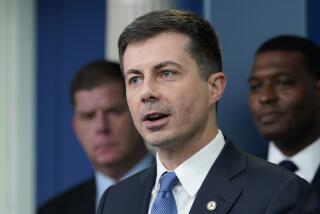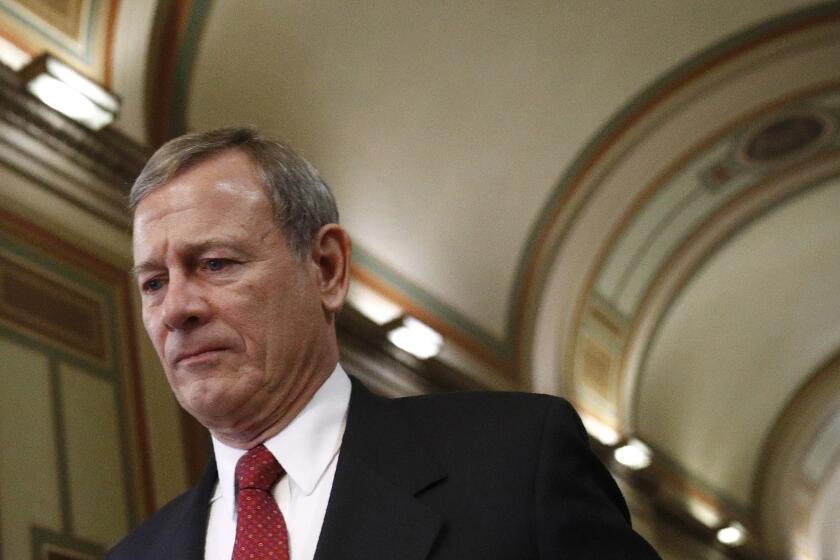FAA Chief Blasts Restrictions on Noise
- Share via
The biggest obstacle facing aviation is the noise restrictions that hamper expansion of existing airports and the building of new ones, the head of the Federal Aviation Adminstration said Thursday.
Acknowledging the chronic flight delays and record numbers of near-collisions that have plagued the nation’s air transport system recently, FAA Administrator T. Allan McArtor told a conference of aviation executives meeting in Anaheim that the problems are, in part, caused by crowded skies, which can be eased only by new and expanded airports.
But because this aim has often been thwarted by the objections local residents have to the noise that airports bring, McArtor called for “a national noise policy so that local jurisdictions will not have their own restrictions.”
McArtor conceded that the air transport system suffers from a “crisis of confidence,” saying that the public’s “confidence level has been eroded, and in many cases unnecessarily so.”
‘Finest in the World’
“Our nation’s air transit system is the finest in the world, it’s the safest in the world, it’s the most efficient in the world,” McArtor said.
While acknowledging that effects of airline deregulation in the late 1970s--along with President Reagan’s dismissal of striking air traffic controllers in 1981--have caused much of the havoc plaguing the industry, McArtor rejected suggestions that government re-regulation of air transit would solve the problems.
The aim of federal policy, the administrator said, should be “not to restrict air travel, but the establishment of more air space.”
McArtor’s views were seconded by a panel of airline presidents who met later in the day. While opposing any increase in government control over air travel, the presidents of USAir, American and Trans World airlines called for massive federal investment in building airports, modernizing the air traffic control system and overriding local restrictions of airport noise.
‘Media Feeding Frenzy’
American Airlines President Robert Crandall said “one-third of all near-misses experienced by our airline have been here (over the Los Angeles Basin), even though only 4% of our flights originate here.”
That notwithstanding, Crandall went on to decry “a media feeding frenzy,” whereby the news media has focused on unflattering aspects of the airline industry, such as the rising incidence of near-collisions, and the scheduling and service problems that have emerged as a national issue.
Crandall described as “nonsense” such proposals for improving service as imposing fines on airlines for lost luggage.
Instead, to cure the ills of aviation, “We’ve got to build a lot of new airports and runways,” he said.
That effort, he said, should be comparable to the construction of interstate highways in the 1950s. Because such a project would be faced with strong objection from residents, Crandall called for “some kind of federal preemption” of local authority over airport noise.
The presidents of USAir, Edwin I. Colodny, and of TWA, D. Joseph Corr, among others, expressed similar views.
Effects of Deregulation
Speaking of the effects of deregulation on the airline industry, McArtor said, “We don’t have any indication that (it) contributes anything directly to (a weakening) of air safety.”
A former fighter pilot who assumed his post in July, McArtor qualified that remark by adding: “I think maybe a a couple of years ago (the airlines) thought the maintenance programs were a pocket to be picked. Some very dramatic fines (imposed upon airlines by the FAA) highlighted the fact that that simply is not allowed, and I think our airlines have accepted their responsibilities” for maintaining the airworthiness of their fleets.
While he did not criticize Reagan for firing the striking controllers six years ago, McArtor said that action “certainly set us back with our ability to plan for the future and adjust to the future. We find ourselves scrambling to catch up to where we’ve been, and we still find ourselves measuring with respect to 1981 pre-strike numbers.”
‘Near-Miss Every Day’
Responding to the record number of near-collisions reported in the skies over Southern California, McArtor said: “It’s not that it seemed like a near-miss every day. We’ve had a near-miss every day.”
He ascribed the higher numbers to better reporting of the events by pilots and also to the congestion in the airways. But he said the figures were statistically insignificant and did not represent a deterioration of air safety.
More to Read
Sign up for Essential California
The most important California stories and recommendations in your inbox every morning.
You may occasionally receive promotional content from the Los Angeles Times.










